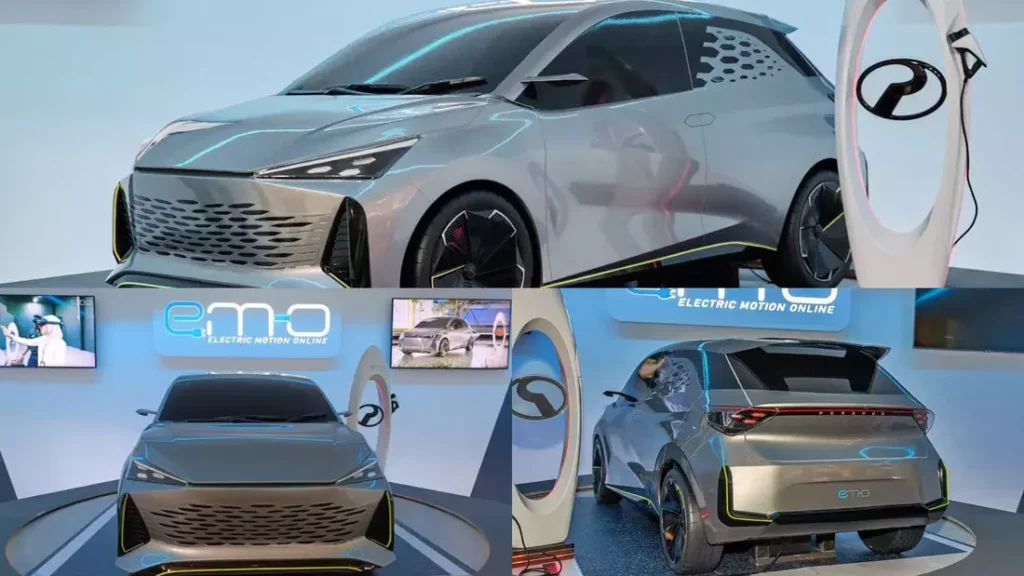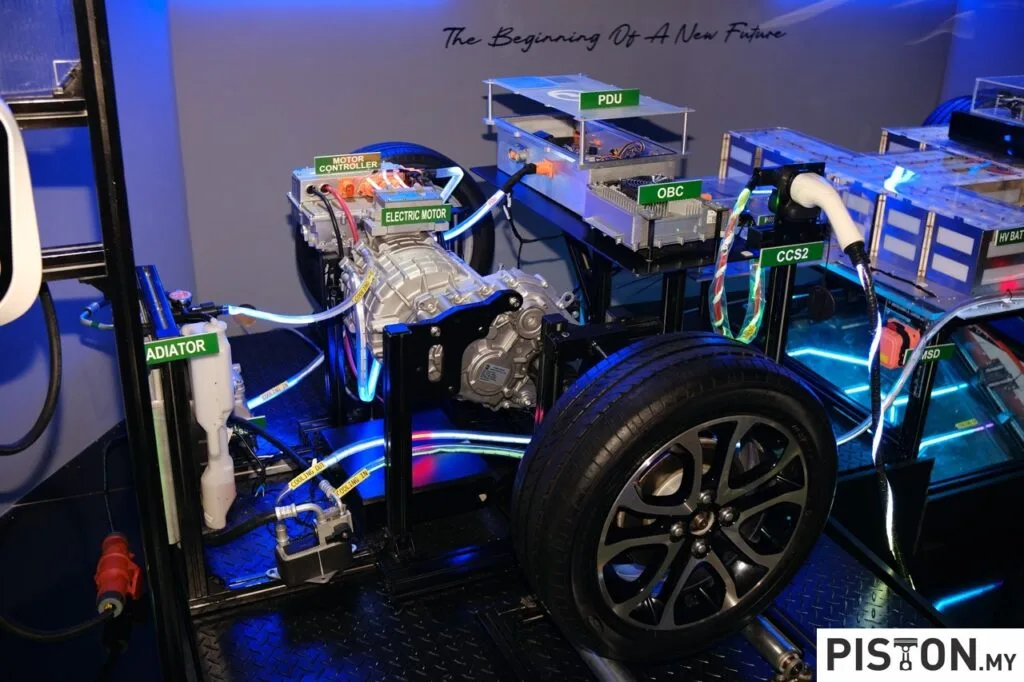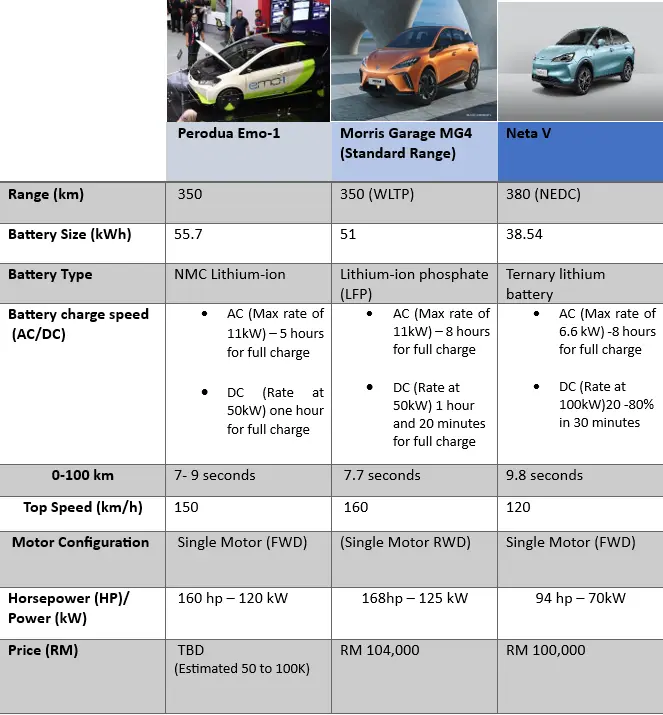PERODUA’S CONCEPT EV, EVERYTHING YOU NEED TO KNOW ABOUT PERODUA’S NEXT EV MODEL.
Perodua, famous for its budget-centric car Myvi, being the people’s choice owning the title of Malaysia’s best-selling car for 14 consecutive years since 2006, has started development in tailoring the heightened interest trending for electric vehicles. Can the national carmaker triumph once more with their first model EV that is soon to debut?
Perodua’s first futuristic concept towards its EV entry.
During KLIMS (Kuala Lumpur International Mobility Show) 2023, Perodua displayed its interest in the making of an electric vehicle by showcasing EMO (Electric Motion Online) where at first glance the vehicle’s contours shared a similar size footprint to that of the Perodua’s famous model offering, Myvi.

The concept vehicle is built out of clay and is based on a 1:6 scale, its exterior features a sleek and modern outlook akin to current generation EVs and is what should be expected for Perodua’s electrification of its future EV.
Is Perodua alone in the development of its future EV?
As explained by the Minister of Investment, Trade, and Industry (MITI), YB Senator Tengku Datuk Seri Utama Zafrul Abdul Aziz, the EV model by Perodua is to be co-developed with an “international company”. Although not directly implied, Perodua’s CEO Dato Sri Zainal Ahmad has shared confirmation that its technical partner Daihatsu will be Perodua’s named “international company”.

Does Daihatsu have the requirements to back Perodua’s EV development?
Daihatsu has its fair share of electric vehicles; however, they are unable to price the vehicles correctly for them to proceed and put them under production. Existing attempts such as the Perodua Ativa hybrid during 2022, are only offered to selected customers as a subscription due to how high of a price the vehicle costs. The vehicle was also not available in showrooms.

Dimensions of the EMO first concept compared to Myvi 3rd generation

Perodua’s concept EV’s expected performance and specification
Perodua stated that the EV concept would feature the following specifications during KLIMS:
- 95 PS and 121Nm torque for its electric motor
- 0-100 Km/h in 10 seconds
- Top speed: 160 km/h
- 50 kWh featuring a speculated range of 300-350 km
DC charging of up to 300kW, 20 minutes of charge to 80% state of charge
Perodua’s working EV concept prototype, emo 1.
A year has passed since the introduction of the 1st concept EV by Perodua, since then Perodua has been hard at work independently at giving us another optimistic look towards its progress by unveiling its working EV concept, the emo-1. From its development ever since September 2022, Perodua’s booth during Malaysia Autoshow 2024, displayed a 3rd generation Myvi (2021) that had some parts of it exchanged to suggest the electrification of its next-generation EV.

What sets the emo-1 apart from the regular 3rd generation Myvi?

Some exterior and interior changes to the Myvi 3rd generation frame were also apparent when observed which include:
- Gone are the side mirrors replaced by cameras that feature a monitor near the front left and right A-pillars on the dashboard.
- A centre console that extends from the front dash to the back
- A bigger LCD panel display
- Flat top and bottomed steering wheel wrapped in Alcantara
- Re-designed rim / hubcap
Given that the exterior design of the current Myvi might not be up to your standards of what a next-generation EV from Perodua should look like, don’t worry as the company’s president and chief executive officer Dato’ Sri Zainal Abidin stated that the design is set to change and will appear relatively different than what is displayed on the Motorshow.
The new emo-1, electrification at the cost of passenger space
The reasoning behind this is due to its change to the floorplan to accommodate the battery where the focus is shifted towards ensuring that occupants aren’t sitting awkwardly due to how the floor-mounted battery is placed and designed. Perodua has taken cues from existing designs such as the Porsche Taycan’s battery pack to incorporate into theirs which focuses on:
- Split battery design following a H pattern for the main battery.
- Hollow space along the H pattern allows for space for occupants to rest their legs
- 150 mm ground clearance
- Secondary battery housed under the boot floor

Performance and spec wise is it similar to the acclaimed a year prior?

Certain specifications of the concept vehicle have changed following the working prototype, emo-1.
The insides that enable Perodua’s claim of a working prototype
The working prototype has 2 main parts which replace the engine from its ICE variant Myvi frame which is the first of many episodes in which entails to its end product.
- Power bench
- Power Converter

The power conversion technology is developed by a company in Australia, EV North. Whereas other areas of development were under local Malaysians:
- 60 local vendors supplying the required tools
- 3 local universities, University Tenaga Nasional, University Kuala Lumpur and University Putra Malaysia in understanding BEV system architecture as well as High voltage components and electric powertrains.
- 12 engineers from Perodua with educational backgrounds within the fields of electric, electronic and mechanical engineering with a budget allocation of RM 2 million.
Is the battery charging speeds of the emo-1 compelling?
The battery charging speeds of an electric vehicle should be comparable to the current offerings of the EV market today, if not better. The convenience of having a battery that can fast charge is critical and stems as a major pillar in the practicality of EV ownership. The charge speeds of the emo-1 are as follows:

Home charging for the electric vehicle seems adequate for an overnight charge, however, to understand more about the types of AC charging available for residential owners and its perks in owning a charging station at home, Energi Elite has made it less trivial to own a charging station.
Comparison of similar segment EV in current market

Pricing of Perodua’s upcoming EV
What’s known currently regarding the manufacturing of Perodua’s first EV is that
With government restrictions over imported EVs to be not less than RM 100,000, it would make sense that local manufacturers such as Perodua, grab the opportunity to elevate their footing as Malaysia’s first proper affordable EV, hence as stated the pricing range will be along the lines of:
- RM 50,000 – RM 100,000
Perodua’s upcoming EV will be locally manufactured
Perodua also has intentions to corroborate with its technical partner and shareholder, Daihatsu in the manufacturing and assembly of its upcoming EV locally. Given that it might come to fruition, the EV pricing of below RM 100,000 could be realized and succeed as its appointed lead of affordable EV under the New Industrial Master Plan 2030.
Launch dates are hinted by MITI minister
Launch dates of Perodua’s EV according to MITI’s minister, Tengku Datuk Seri Abdul Aziz on social media platform, X, is said to launch at:
- Mass production scheduled to start near end of 2025
Conclusion
With the complete acquisition of a 100% stake by Sime Darby in UMW Holdings Berhad which is to scale up the group’s motor business and having a strong market share of brands such as Perodua, Toyota, Lexus, Hyundai, and BYD. It is interesting to note that development of Perodua next EV could possibly have ties with the listed brands under Sime Darby’s belt , unified as a single group. Ultimately, Perodua has taken healthy steps towards the making of its upcoming EV showing growth in each concept that’s been released thus far. Only time will tell if the national automaker can shake grounds for the segment of a truly affordable EV for Malaysians.




